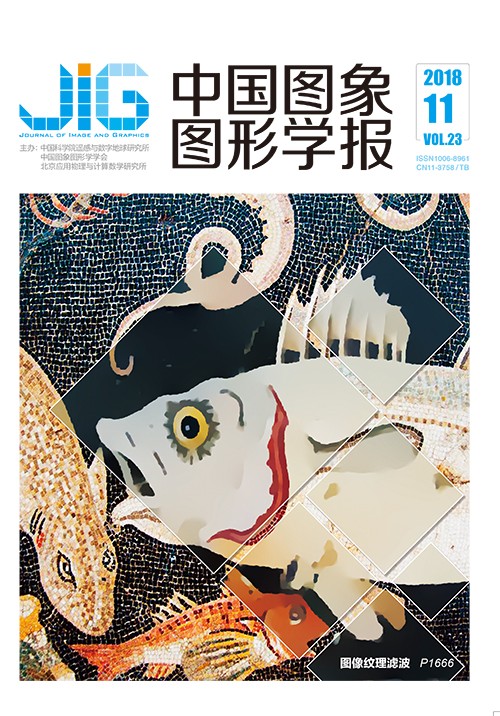
用于盗版追踪的格雷码加密域可逆水印研究
石慧1, 冯斌2, 王相海1, 李明楚3, 宋传鸣1(1.辽宁师范大学计算机与信息技术学院, 大连 116029;2.泰山学院信息科学技术学院, 泰安 271000;3.大连理工大学软件学院, 大连 116621) 摘 要
目的 现有水印算法大多是基于明文域的,很容易被入侵、窃取。为了保护用户隐私、提高安全性,本文提出了一种用于盗版追踪的基于格雷码加密域的可逆水印方法,该方法支持对密文直接操作。方法 首先提出了基于格雷码的同态加密系统(HESGC),并以此加密载体图像;然后依据整数小波变换(IWT)和人类视觉系统(HVS)特性,将图像分区并合理分类;再依据新提出的算法完成嵌入、可逆恢复及提取工作;最后利用首次提出的水印追踪联合策略(JWT)来进行盗版追踪。结果 为了验证本文方法,选取USC-SIPI图像库中的6幅经典图像作为标准测试图像,与其他可逆水印算法相比,本文方法具有更高的PSNR值,PSNR高达50 dB,而且SSIM值均为1,实现了可逆功能;本文新提出的HESGC将使原始载体图像膨胀为原来的8倍,故容量较大。理论上,本文最大容量为3.75 bit/像素,目前大多可逆水印算法的最大容量不足1 bit/像素;本文方法不仅实现了盗版追踪功能,而且能够抵抗一些常见的攻击,如随机噪声、中值滤波、图像平滑和JPEG编码、LZW编码和卷积模糊等。通过比较原始追踪证明与攻击后图像的追踪证明可知,相似度在1左右的即为盗版,其他非盗版的相似度都远远低于1,大部分在0.6左右。结论 本文提出了一种基于密文域的可逆水印方案,首次提出了HESGC和JWT,实现了密文域可逆水印技术和盗版追踪功能。该方案直接采用灰度图像作为水印图像,解除了以往以二值图像作为水印图像,或者将灰度图像二值化后作为水印图像的限制,而且采用基于级联混沌技术提高了灰度水印图像的安全性。此外,本文成功消除了图像分区分类中纹理/平滑区域中的平滑/纹理孤岛,使分类结果更加准确、合理。实验结果表明,本方案不仅能够抵抗一些常见攻击,而且容量大、安全性高,很好地保护了用户隐私。本文实现了密文域可逆水印技术,适用于隐私保护要求高的医学、军事等领域。
关键词
Reversible watermarking in encrypted image based on Gray code for piracy tracing
Shi Hui1, Feng Bin2, Wang Xianghai1, Li Mingchu3, Song Chuanming1(1.Computer and Information Technology College, Liaoning Normal University, Dalian 116029, China;2.School of Information Science and Technology, TaiShan University, Taian 271000, China;3.School of Software Technology, Dalian University of Technology, Dalian 116621, China) Abstract
Objective The rapid evolution of cloud technology has provided users with convenience but still has security risks. Users' privacy (e.g., personal photos, corporate user information, and electronic notes) will be exposed once the cloud data are inaccessible or corrupted. Owing to the existence of security vulnerabilities or internal staff illicit activity, data may be tampered, replaced, or distributed illegally. In such a case, protecting the user' privacy is crucial. Currently and in practice, protecting the users' privacy is achieved by watermarking technology, especially reversible watermarking technology. Reversible watermarking can not only extract data correctly but also completely restore the original carrier. This technique is used in the medical, military, and other fields. Therefore, reversible watermarking technology plays an important role in the privacy protection field. Most of the existing reversible watermarking algorithms are based on the plaintext domain, such that they can be easily pirated or tampered. Thus, we proposed a reversible watermarking scheme in the homomorphic encrypted domain on the basis of Gray code for piracy tracing to enhance security and protect privacy. The proposed scheme provides support for a direct operation in the homomorphic encrypted domain. The ultimate goal of the new proposed scheme in the encrypted domain is to protect the users' privacy. Method First, the "homomorphic encryption system based on Gray code" (HESGC) is proposed to encrypt the original carrier image. Gray code encryption converts the grayscale values of the original carrier image into binary values. Second, in accordance with integer homomorphic encryption, the binary values are converted into different decimal grayscale values. Subsequently, region division and classification can be reasonably performed in accordance with the "integer wavelet transform" and "human visual system" characteristics. Region division is used to avoid conflicts between watermarking and tracing proofs, and region classification fits well with human visual characteristics. Humans are sensitive to smooth regions and minimally sensitive to the textured regions. Moreover, neighboring quadratic optimization approach is presented to improve the concentration of the same regions and enhance the accuracy and reasonability of region classification. Third, we implement the proposed embedding, reversible recovery, and extraction operations. Finally, we present "joint watermarking and tracing" (JWT) strategy and utilize it to achieve piracy tracing. The JWT strategy can trace piracy and the first unauthorized person who illegally copies or distributes the image. This study uses the nonrepudiation of tracing proofs. Result Experiments on the commonly used image database (i.e., USC-SIPI) are conducted. Six classical images from the USC-SIPI image database are selected for this experiment. The proposed algorithm has higher peak signal-to-noise ratio (PSNR) values than the existing reversible watermarking algorithms, and the PSNR value can reach 50 dB. In addition, the structural similarity index metric values of the original carrier, restored, original watermarking, and extracted watermarking images are all equal to 1. The proposed scheme achieves a reversible recovery. Furthermore, the proposed HESGC expands the original carrier image by eight times, thus increasing the capacity. Theoretically, the maximum capacity of the algorithm proposed in this study is 3.75 bit/pixel. Currently, the maximum capacity of most existing reversible watermarking algorithms is less than 1 bit/pixel. Moreover, the proposed scheme can not only achieve piracy tracing but also resist several common attacks, such as random noise, median filter, image smoothing, JPEG-coded, LZW-coded, and convolutional fuzzy attacks. We calculate the similarity value of the extracted and generated tracing proofs by the image copyright owner and determine who has the maximum similarity value to identify the piracy origin. If the similarity value is approximately 1, then it is a pirate. For other non-pirates, the similarity value is less than 1, most of which are approximately 0.6. Experimental results confirm the efficiency of the proposed scheme. Conclusion In this study, we present the HESGC and JWT for the first time to achieve piracy tracing and reversible watermarking in an encrypted image. Most of the existing reversible watermarking algorithms directly use a binary sequence as the watermark. Alternatively, the gray image in this scheme serves as the watermark image directly; the restrictions when the binary image is used as the watermark image are removed, or the gray image is binarized as the watermark image. Moreover, cascade chaotic technology is adopted to encrypt the gray watermark image to enhance its security. We also successfully eliminate the smooth/textured islands in the textured/smooth regions, such that the block classification results are accurate and reasonable. In particular, security is an important measurement indicator for privacy protection, where only a secure watermarking system is meaningful. This study examines a triple security protection mechanism, which has the strongest security performance. The experimental results indicate that this scheme not only achieves privacy protection and piracy tracing but also has the characteristics of high security, large capacity, and high restoration quality. Moreover, this scheme can resist several common attacks, which are suitable for protecting users' privacy. The proposed algorithm focuses on the reversible watermarking technology in an encrypted image and is widely applied to digital images, such as military images, medical images, electronic invoice, and legal documents, that require high confidentiality, security, and fidelity.
Keywords
privacy protection reversible watermarking piracy tracing HESGC(homomorphic encryption system based on gray code) JWT(joint watermarking and tracing) high capacity high security
|



 中国图象图形学报 │ 京ICP备05080539号-4 │ 本系统由
中国图象图形学报 │ 京ICP备05080539号-4 │ 本系统由